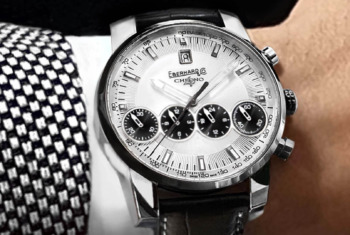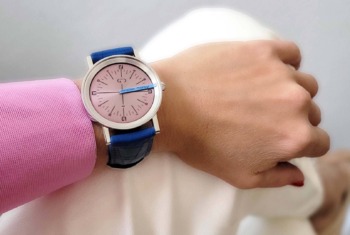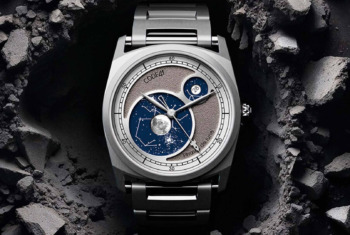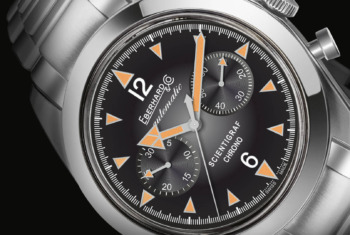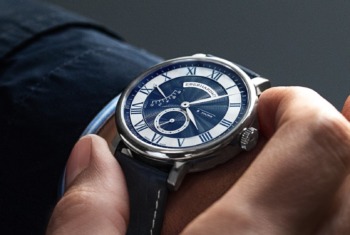
TOUGH CALL
Apart from the winding mechanism which sets the Junghans Max Bill automatic winder apart from its manual counterpart, the two models show differences in other characteristics and features too. Case size, the date display, and ultimately the price, these factors are likely to influence your buying decision. Let us take a closer look at the two Max Bills and perhaps we can offer you some insights in choosing the model that is best for you.
Midsize vs. Full Size
One requires you to regularly wind it by hand, while the other begets its energy automatically every time you move your wrist, the winding mechanism certainly affects the way you use the watch. However we will not discuss it in detail here, as the general preference for either manual-winding or automatic watches is a personal choice. However, if you are interested to learn more about this, you can refer to our article about hand wound vs. automatic watches here. Other than this most obvious difference, there are some other details that may sway your decision in the direction of one or the other model.
First of all, watch size. The automatic Max Bill boasts a diameter of 38mm compared to the slender diameter of the manual-winding Bill which measures only 34 mm. This significant difference in size leads to most male watch connoisseurs choosing the more prominent appearance of the automatic Max Bill. Junghans made an excellent choice with this size, as it fits right in with its modern peers without appearing oversized or overstated. It renders a well-executed modern interpretation of the watch classic by carefully retaining the perfectly balanced proportions in its new design. On the other hand, the 34mm housing of the manual version may well look undersized. However, make no mistake, its popularity is not hindered a bit and people with slender wrists will definitely appreciate the fit.
Vintage Charm vs. Modern Retro Interpretation
Whether you prefer the larger or the smaller watch, ultimately it is not a reflection of your wrist size or personal preferences. To some degree your selection makes a fashion statement, that places you either on the side of the genuine vintage charm or the contemporary interpretation of the retro design. Especially at this time, when many watches boast exuberant dials and oversized housings, many connoisseurs are delighted by the anachronistic character statement that the manual Max Bill incorporates.
Technical Facts
Let’s see how the new automatic and manual models have changed, compared to their original versions from the sixties. Of course there are significant technical advances, while the original Bills were furnished with inhouse movements, the current models are ticking on proven calibers from the house of ETA. In contrast, the dial design of both versions is a meticulous reproduction of the original, with barely any deviation.
The shape of the housing has remained virtually unchanged in both models, except for the size of the Automatic Bill. It has increased from its original 36mm to the new size of 38mm. If you are looking for a reissued model of the Max Bill by Junghans, that is true to its original version from the sixties, you will probably opt for the manual winder. At its first issue in the early sixties it measured the same 34mm diameter that it has today.
Date vs. No Date
The automatic model sports the ETA 2824 movement while the manual model is ticking the ETA 2801. Both calibers are equal in their construction, but the 2801 suffices without rotor and without date display. The lean and the automatic version of the Bill are essentially equivalent in all objectively measurable indicators. The same is also true for their robustness and reliability as well as the exactitude of the timepiece.
Few watch features draw a dividing line among the circle of watch enthusiasts as decidedly as the classic date display does. One side considers it to be indispensable in a watch, second only to the telling of time itself. The other half sees it as a nuisance. Especially when the watch is not worn regularly and they need to adjust the date in addition to setting the time on the occasion of taking it out. Regardless which side of that line you find yourself on, for the Automatic Bill with its 2824 caliber, you have the choice of a version with date display and a reduced version without date, the time-only model. Junghans’ Manual Winder Bill on the other hand, foregoes the date function entirely. Contrary to popular belief, the 1960’s original version was actually offered with the option of a date feature. However, very few watches were made of this limited edition Max Bill with date display.
The list price for a manual Junghans Max Bill is 625.00 EUR, the automatic versions have an MSRP manufacturer’s suggested retail price of 875.00 EUR without the date feature and 925.00 EUR with the date feature included.




